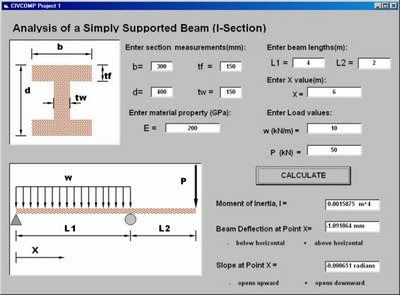
Beam Deflection Application: This is a software application for solving the elastic deflection and slope of a beam. The inputs to the program are the cross-section dimension and properties of the I-section and the beam loadings and lengths. The outputs include the moment of inertia of the I-section, the beam deflection and slope at specified point X from the left end. This application may be used in the course on Mechanics of Materials or Structural Analysis to demonstrate the effect of section properties, beam loading and lengths on the elastic deflection and slope of a beam. By computing the deflection of the beam at different values of X, the shape of the elastic curve can be drawn.

Open Channel Flow: This software application determines the normal depth of an open channel using Manning’s Equation. In this program, the user first selects the shape of the cross-section: (a ) rectangle, (b) trapezoid, or (c) triangle. The system of units have to be chosen also. The inputs to the program are the dimensions of the cross-section and Manning equation parameters, S, n and Q. The output of the program is the normal depth of flow. This software application can be used in the courses, Fluid Mechanics or Hydraulics. The values of the various parameters, such as dimensions of the cross-section, slope of channel bed, coefficient of roughness or flow rate, maybe varied to study the effect on the normal depth of flow.
You may download and try these programs at my website at http://mysite.dlsu.edu.ph/faculty/oretaa.








i remember this course name was CENCOMP.
ReplyDeletewe started from Turbo Pascal codes, wayback when the environment we're using is still MS DOS...then it became Turbo C/C++ and when I was still there @ DLSU-M as an RA, i found out that they were using Visual Basic already...but i found out also that VB is not a structured language, as compared to that of last two.
I wonder...what happened to the diskettes/CDs where our last Machine Project (group of 3 members) was saved? Is there any way we can preserve those "nice" and "turn-of-the-century" computer programs? Ours was MODICBE or Moment Distribution method for Continuous Beam.
thank you Doc Andy for those activities you put in that handy course named CENCOMP. What an experience!
mike baylon ID#93
P.S.
even now, i'm still reminiscing those unforgettable experiences and share it to my engineering students here in my school...ty!
Yes, VB is object-oriented programming and not structured like Pascal or C. At first it was difficult to adjust to VB programming if you were trained using structured programming. But eventually you will get used to VB and will find it more user friendly and it has nice outputs - GUI's.
ReplyDeleteamazing VB programming! very nice.
ReplyDeleteStumbled a VBA site on civil finally, nice app. Sometime ago out of passion I wrote a few app. using VB6 to automate drafting. Source codes uploaded on this eggBlog. Nice if reviewed by experts. tq
ReplyDeleteNice post. I learn something new and challenging on websites I stumbleupon
ReplyDeleteeveryday. It will always be useful to read articles from
other authors and practice a little something from other web sites.
My page - Click For Info
Enter your comment...Thank you
ReplyDelete